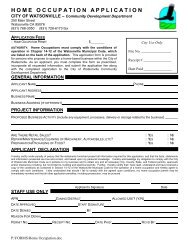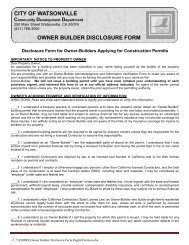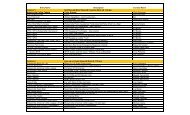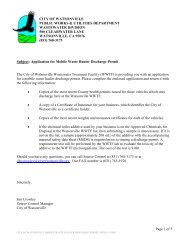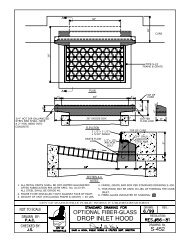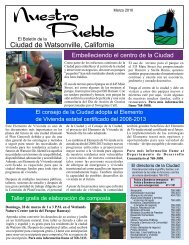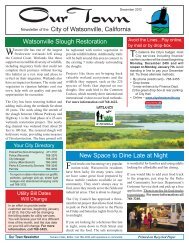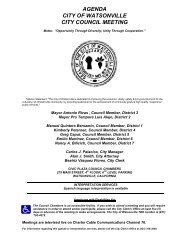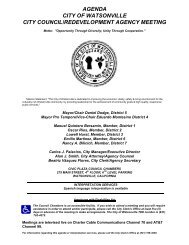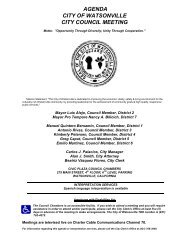Vegetation Management and Maintenance Plan - Watsonville ...
Vegetation Management and Maintenance Plan - Watsonville ...
Vegetation Management and Maintenance Plan - Watsonville ...
You also want an ePaper? Increase the reach of your titles
YUMPU automatically turns print PDFs into web optimized ePapers that Google loves.
3.1.9 Active Revegetation<br />
Within the VMMM project area, active revegetation is a suitable follow-up treatment for areas<br />
where infestations of thistles (Italian thistle, slender-flowered thistle, bull thistle), bristly oxtongue,<br />
poison hemlock, <strong>and</strong> French broom have been removed. Active revegetation is a critical<br />
requirement for eradication <strong>and</strong>/or long-term control of Harding/canary grass. In suitable areas,<br />
revegetation efforts can include broadcast seeding <strong>and</strong> direct plantings of plugs <strong>and</strong> other<br />
container stock. Revegetation efforts should utilize native plant species that are aggressive<br />
competitors with invasive species. Grass species, such as blue wild rye (Elymus glaucus) are<br />
recommended for many post-eradication areas. Other herbaceous <strong>and</strong> woody plant species are<br />
also recommended, as listed in Table 6 below.<br />
In areas immediately adjacent to a trail, where trail user visibility is a concern, low-growing<br />
shrubs <strong>and</strong> herbaceous plant species are recommended. If a dense cover of native plant species<br />
can be established, weed recruitment in these areas will be substantially reduced.<br />
Vegetated buffer zones can also be established using active revegetation. The VMMM identifies<br />
projects to establish low-growing evergreen buffer areas between residential yards, slough trails,<br />
<strong>and</strong> City open space areas. Evergreen buffer plantings will reduce weed infestations, reduce grass<br />
cover <strong>and</strong> fire hazards, <strong>and</strong> promote native plant habitat. Low-growing evergreen shrubs suitable<br />
for buffer plantings are listed in Table 6.<br />
Table 6. <strong>Plan</strong>t Species Suitable for Revegetation within the VMMM Project Area<br />
Common Name Scientific Name Typical <strong>Plan</strong>t Typical Propagule Size<br />
Spacing<br />
Vegetated Buffer Areas<br />
Dwarf Coyote Brush Baccharis pilularis pilularis 6 1 gallon or Dee pot<br />
‘Pigeon Point’<br />
Hooker’s Manzanita Arctostaphylos hookeri 6 1 gallon<br />
Dwarf Wild Lilac<br />
Ceanothus griseus<br />
6 Dee pot<br />
horizontalis<br />
Coffee Berry Rhamnus californica 6 1 gallon or Dee pot<br />
Bee’s Bliss Sage Salvia ‘Bee’s Bliss’ 6 1 gallon or Dee pot<br />
Low-Growing Trail Edge Revegetation<br />
Spreading Rush Juncus patens 4 2-inch pot<br />
Common Yarrow Achillea millefolium 4 2-inch pot<br />
Wood Strawberry Fragaria vesca 4 2-inch pot<br />
Creeping Wildrye Leymus triticoides 2 2-inch pot or plugs<br />
Foothill Sedge Carex tumulicola 2 2-inch pot or plugs<br />
Blue-eyed Grass Sisyrinchium bellum 4 2-inch pot<br />
California Meadow Sedge Carex pansa 4 2-inch pot<br />
Creeping Sage Salvia somomensis 6 1 gallon or Dee pot<br />
Scrub Revegetation Areas<br />
Sticky Monkey Flower Mimulus aurantiacus 6 1 gallon<br />
California Rose Rosa californica 6 1 gallon or Dee pot<br />
Snowberry Symphoricarpos rivularis 6 Dee pot<br />
Mugwort Artemisia douglasiana 6 Dee pot<br />
Coyote Brush Baccharis pilularis 6 1 gallon or Dee pot<br />
California Blackberry Rubus ursinus 6 Dee pot<br />
California Aster Aster chilensis 6 Dee pot<br />
Deerweed Lotus scoparius 6 Dee pot<br />
California Sagebrush Artemisia californica 6 2-inch pot<br />
<strong>Vegetation</strong> <strong>Management</strong> <strong>and</strong> <strong>Maintenance</strong> Manual<br />
Draft 28 July 27, 2007




